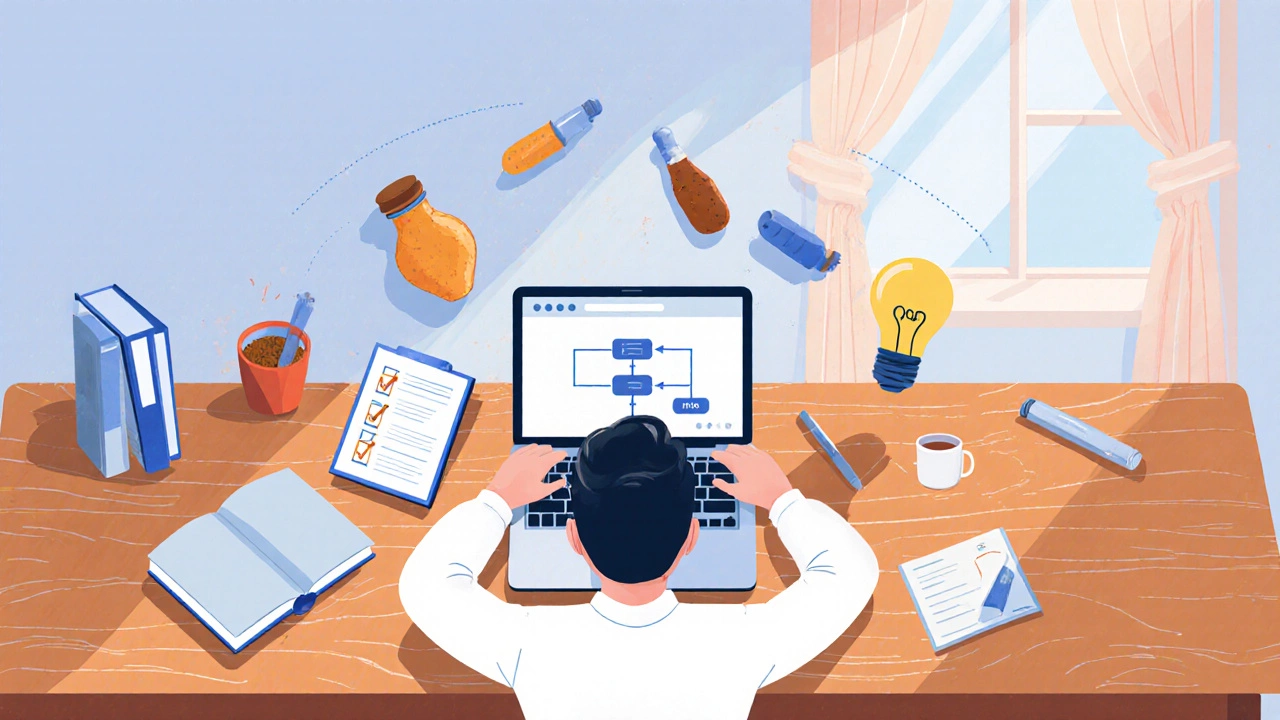
eLearning models are a set of structured approaches used to design, develop, and evaluate digital learning experiences. If you’ve ever wondered why some courses feel smooth while others feel like a maze, the answer usually lies in the model behind the scenes. In this guide we’ll break down the five most widely‑used eLearning models, show where each shines, and give you a quick checklist to pick the right one for your next project.
Why a model matters
Think of an eLearning model as a recipe. You could throw flour, eggs, and sugar together and hope for a cake, but a proven formula guarantees consistent results. The same principle applies to online instruction: a solid model reduces wasted time, aligns content with learning goals, and provides measurable checkpoints.
1. ADDIE Model - The Classic Blueprint
ADDIE model is a five‑phase framework (Analysis, Design, Development, Implementation, Evaluation) that has been the backbone of corporate and academic training since the 1970s. It starts with a deep dive into learner needs, then moves step‑by‑step toward delivery and continuous improvement.
- Analysis: Identify gaps, define objectives, and understand the audience.
- Design: Sketch storyboards, choose media, and outline assessments.
- Development: Build the actual course - videos, quizzes, simulations.
- Implementation: Deploy on an LMS, train instructors, and launch.
- Evaluation: Gather feedback, measure performance, and iterate.
ADDIE works best when you have ample time for planning and need a clear audit trail for compliance or accreditation.
2. SAM (Successive Approximation Model) - Fast‑Track Iteration
SAM (Successive Approximation Model) was introduced in the early 2000s to address the slowness of traditional linear models. Instead of waiting for a full analysis before prototyping, SAM encourages rapid cycles of design‑prototype‑test.
- Preparation Phase - Define goals and constraints quickly.
- Iterative Design Phase - Create a low‑fidelity prototype, test with real users, and refine.
- Iterative Development Phase - Build higher‑fidelity versions, keep testing, and finalize.
Teams that need to respond to changing business requirements or technology updates often favor SAM.
3. ARCS Model - Motivational Engine
ARCS model focuses on learner motivation by addressing Attention, Relevance, Confidence, and Satisfaction. While it can be layered onto any instructional framework, its core intent is to keep learners engaged from start to finish.
- Attention: Use surprise, novelty, or storytelling.
- Relevance: Connect content to real‑world tasks or goals.
- Confidence: Provide clear expectations, scaffolding, and low‑stakes practice.
- Satisfaction: Offer feedback, rewards, and opportunities for reflection.
ARCS is especially useful for MOOCs, soft‑skill courses, and any environment where dropout rates are high.

4. Kirkpatrick Model - Measuring Impact
Kirkpatrick Model evaluates training effectiveness across four levels: Reaction, Learning, Behavior, and Results. It was originally designed for classroom training but translates well to digital formats when paired with proper analytics.
- Level 1 - Reaction: Learner satisfaction surveys.
- Level 2 - Learning: Pre‑ and post‑tests to gauge knowledge gain.
- Level 3 - Behavior: Observation or self‑reporting of on‑the‑job changes.
- Level 4 - Results: Business impact such as sales lift, error reduction, or time saved.
If your organization demands ROI proof, Kirkpatrick gives a clear reporting structure.
5. Bloom’s Taxonomy - Learning Objectives Backbone
Bloom’s Taxonomy classifies cognitive skills into six levels (Remember, Understand, Apply, Analyze, Evaluate, Create) and guides objective writing. Though not a full‑blown development process, it ensures that every activity targets a specific mental skill.
- Remember: Flashcards, recall quizzes.
- Understand: Summaries, concept maps.
- Apply: Simulations, scenario‑based tasks.
- Analyze: Case studies, data interpretation.
- Evaluate: Peer review, critique exercises.
- Create: Project‑based assessments, portfolio builds.
Use Bloom’s when you need precise alignment between assessments and learning outcomes.
Comparison at a glance
| Model | Core Focus | Typical Timeline | Best For | Primary Metric |
|---|---|---|---|---|
| ADDIE | Structured design‑development‑evaluation | Medium‑Long (3‑6 months) | Compliance, Certification, Large orgs | Completion & Accuracy |
| SAM | Rapid prototyping & iterative feedback | Short (4‑8 weeks) | Tech‑savvy teams, Agile environments | Iteration cycles |
| ARCS | Motivation & engagement | Variable (depends on content) | MOOCs, Soft‑skill modules | Drop‑out rate |
| Kirkpatrick | Impact measurement | Post‑deployment (3‑12 months) | Corporate ROI reporting | Business results |
| Bloom’s Taxonomy | Learning objective hierarchy | Embedded in any timeline | Curriculum designers, Academic courses | Assessment alignment |
Choosing the right model for your project
Start by answering three quick questions:
- What’s the deadline? If you need a polished product in weeks, SAM wins.
- Do you need proof of ROI? Kirkpatrick adds the measurement layer.
- Is learner motivation a pain point? ARCS should sit on top of any other framework.
Often the best approach is a hybrid. For example, you can run a SAM‑style prototype, embed ARCS techniques for engagement, and later evaluate with Kirkpatrick’s Level‑2 and Level‑4 metrics.

Common pitfalls and how to avoid them
- Skipping analysis: Jumping straight to development leaves gaps in learner needs. Even a lightweight analysis step saves rework.
- Over‑complicating the model: Trying to apply every model at once creates confusion. Pick a primary framework and layer complementary ideas.
- Ignoring data: Without tracking (e.g., quiz scores, completion rates) you can’t evaluate effectiveness. Pair any model with LMS analytics.
- Neglecting accessibility: Accessibility checks belong in the Design phase of ADDIE or the prototype phase of SAM. Fixing it later is costly.
Quick checklist before you start
- Define clear learning objectives (use Bloom’s verbs).
- Select a primary model based on timeline and ROI needs.
- Map each phase to a responsible team member.
- Plan for motivational elements (ARCS) early.
- Set up LMS tracking for Kirkpatrick‑type evaluation.
Putting it all together - A sample workflow
Imagine you’re building a compliance refresher for a finance team:
- Analysis (ADDIE): Identify legal gaps, interview subject‑matter experts.
- Design (ADDIE + Bloom): Write objectives at the “Apply” level, sketch storyboards.
- Prototype (SAM): Create a clickable mock‑up in 2 weeks, test with 5 employees.
- Motivation (ARCS): Add real‑world case studies and badge rewards.
- Development (ADDIE): Produce videos, interactive scenarios, quizzes.
- Implementation (ADDIE): Upload to the corporate LMS, set deadlines.
- Evaluation (Kirkpatrick): Survey reaction, measure post‑test scores, track error‑rate reduction after 3 months.
This blend shows how the five models complement each other rather than compete.
Frequently Asked Questions
Which model is best for a small startup with limited budget?
SAM is usually the go‑to for startups because it lets you launch a functional prototype fast, gather user feedback, and improve without heavy upfront investment.
Can I use more than one model at the same time?
Absolutely. Most seasoned instructional designers blend frameworks - for example, using ADDIE for overall structure, ARCS for motivation, and Kirkpatrick for post‑deployment evaluation.
How does Bloom’s Taxonomy differ from the other models?
Bloom’s focuses solely on the cognitive level of learning objectives, while the other models cover the whole development lifecycle, motivation, or impact measurement.
Is there software that automates ADDIE?
No single tool automates the entire ADDIE cycle, but many LMSs and authoring platforms (like Articulate 360 or Adobe Captivate) provide templates that align with each phase.
What metrics should I track for the ARCS model?
Typical ARCS metrics include engagement time, click‑through rates on interactive elements, satisfaction survey scores, and completion percentages.
Understanding these eLearning models equips you to pick the right roadmap, keep learners motivated, and prove the value of your digital training. Whether you’re a solo course creator or part of a massive corporate L&D team, the right model turns good ideas into measurable results.







